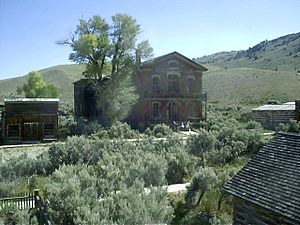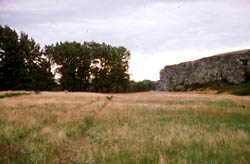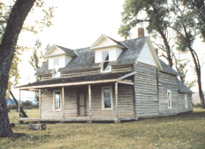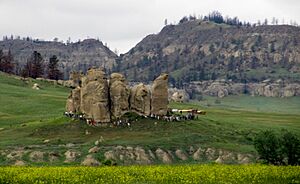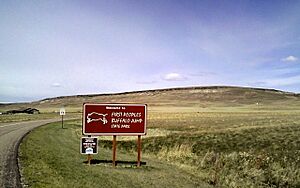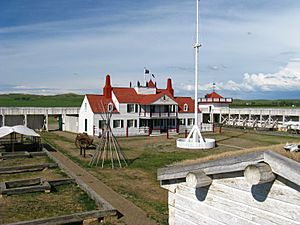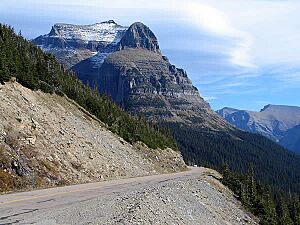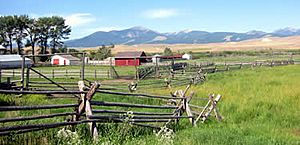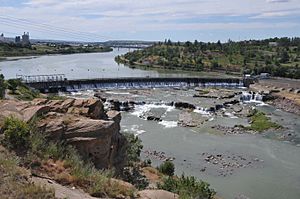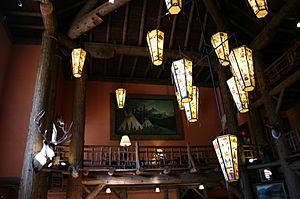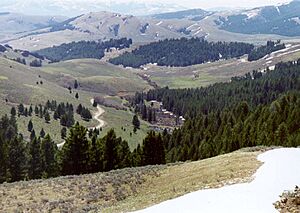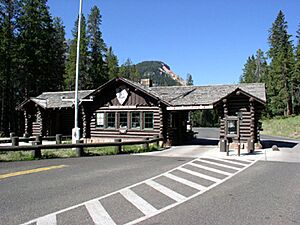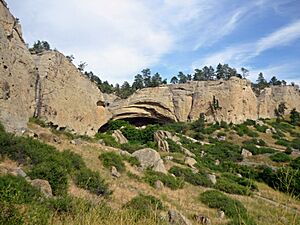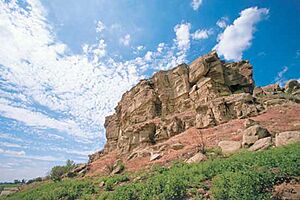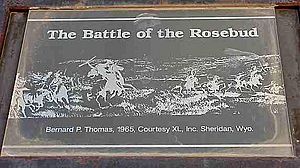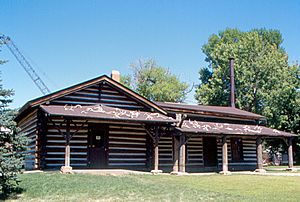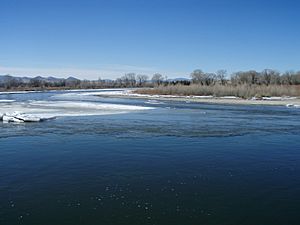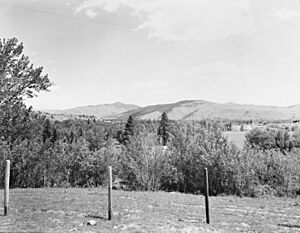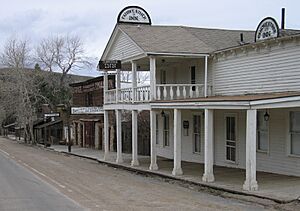List of National Historic Landmarks in Montana facts for kids
The List of National Historic Landmarks in Montana shows special places in the U.S. state of Montana. These places are chosen by the U.S. Federal Government because they are very important to the history of the United States. Montana has 28 of these amazing landmarks.
The National Park Service runs the United States National Historic Landmark program. It finds and recognizes buildings, areas, objects, and other resources across the country. They must meet certain rules to be considered important to the whole nation.
Montana's landmarks often tell stories about its frontier past, the famous journey of the Lewis and Clark Expedition, and Montana's role in creating national parks. They also cover other important historical themes.
Some of Montana's landmarks are so big they cross into other states like Idaho or North Dakota. The National Park Service lists them under those states too.
Contents
- Bannack Historic District
- Butte–Anaconda Historic District
- Camp Disappointment
- Chief Joseph Battleground of Bear's Paw
- Chief Plenty Coups (Alek-Chea-Ahoosh) Home
- Deer Medicine Rocks
- First Peoples Buffalo Jump
- Fort Benton Historic District
- Fort Union Trading Post
- Going-to-the-Sun Road
- Grant-Kohrs Ranch
- Great Falls Portage
- Great Northern Railway Buildings
- Hagen Site
- Lake McDonald Lodge
- Lemhi Pass
- Lolo Trail
- Northeast Entrance Station
- Pictograph Cave
- Pompey's Pillar
- Rankin Ranch
- Rosebud Battlefield-Where the Girl Saved Her Brother
- Charles M. Russell House and Studio
- Three Forks of the Missouri
- Travelers Rest
- Virginia City Historic District
- Burton K. Wheeler House
- Wolf Mountains Battlefield-Where Big Crow walked Back and Forth
- See also
Bannack Historic District
Bannack was the site of Montana's first big gold discovery in 1862. It even served as the capital of Montana Territory for a short time. Today, it's a well-preserved ghost town. You can find it in Bannack, Beaverhead County.
Butte–Anaconda Historic District
This district is one of the largest and most famous "boomtowns" in the American West. A boomtown is a place that grows very quickly, often because of a sudden discovery like gold or silver. The district includes over 6,000 historic buildings and areas. It is located in Butte, across Deer Lodge and Silver Bow counties.
Camp Disappointment
This site is famous because of the Lewis and Clark Expedition. It was a significant stop for the explorers during their journey across America. Camp Disappointment is near Browning in Glacier County.
Chief Joseph Battleground of Bear's Paw
This is where the final battle of the Nez Perce War took place. It was a very important moment in the history of Native American tribes and the U.S. Army. The battleground is near Chinook in Blaine County.
Chief Plenty Coups (Alek-Chea-Ahoosh) Home
This two-story house was the home of Plenty Coups, a respected chief of the Crow Nation, from 1884 to 1932. The landmark also includes a log store and the Plenty Coups Spring. It is located in Pryor, Big Horn County.
Deer Medicine Rocks
Deer Medicine Rocks is a significant historical site located near Lame Deer in Rosebud County. Its importance comes from its historical and cultural value, especially to Native American history.
First Peoples Buffalo Jump
This site is believed to be the largest buffalo jump in North America, and possibly the world. For thousands of years, Native American tribes used buffalo jumps to hunt bison by guiding them over cliffs. It's also thought to be one of the most used buffalo jumps on the continent. It's found near Ulm in Cascade County.
Fort Benton Historic District
Fort Benton was first set up as a fur trading center in 1847. It grew very busy when steamboat traffic increased in 1859 and after a gold strike in 1862. However, its importance lessened when railroads arrived. The district is in Fort Benton, Chouteau County.
Fort Union Trading Post
This was the most important fur trading post on the upper Missouri River until 1867. Many famous people visited here, including artists and explorers. This landmark crosses state lines, located in Williston, North Dakota (in Richland County, North Dakota) and Roosevelt County, Montana.
Going-to-the-Sun Road
This is the main road that goes through the heart of Glacier National Park. It's famous for its stunning views and challenging mountain passes. The road spans Flathead and Glacier counties.
Grant-Kohrs Ranch
John Grant, who owned this ranch from 1853, is sometimes given credit for starting the cattle ranching industry in Montana. Later, Conrad Kohrs bought the ranch around 1866 and became one of the most important "cattle kings" of his time. The ranch is in Deer Lodge, Powell County.
Great Falls Portage
The Lewis and Clark Expedition faced a huge challenge here. They had to carry their boats and supplies for 18 miles around the Great Falls, a journey that took 31 days. This was one of the hardest parts of their trip westward. The Great Falls Portage is within Giant Springs State Park in Great Falls, Cascade County.
Great Northern Railway Buildings
These lodges and related buildings were built around 1913-1915. They are special because they were designed in a European style, which was unique for hotels in National Park Service areas. The landmark includes five groups of buildings: Granite Park Chalet, Many Glacier Hotel, Sperry Chalet, Two Medicine Store, and Belton Chalet. They are located in Glacier National Park, in Flathead and Glacier counties.
Hagen Site
The Hagen Site is an important archeological location near Glendive in Dawson County. It shows evidence of one of the Crow villages from around 1550-1675, after the tribe separated from the Hidatsa people. Scientists have found clues about their farming and diet here.
Lake McDonald Lodge
This beautiful hotel is built in a Swiss chalet style and is located in Glacier National Park. It offers a unique and historic place to stay within the park. It is in Flathead County.
Lemhi Pass
Lemhi Pass is a historic mountain pass that was a key part of the Lewis and Clark Expedition's journey. It crosses the border between Beaverhead County, Montana and Lemhi County, Idaho.
Lolo Trail
The Lolo Trail is another important route used by the Lewis and Clark Expedition. It is a historic trail that winds through the mountains. This landmark spans Missoula County, Montana, Clearwater County, Idaho, and Idaho County, Idaho.
Northeast Entrance Station
This entrance station was built in 1935 in a style called "National Park Service Rustic." It's a great example of how the building's design perfectly fits its purpose as a park entrance. It is located in Yellowstone National Park, in Park County.
Pictograph Cave
Pictograph Cave is one of the most important archeological sites for understanding how prehistoric people lived on the northwestern Plains. Discoveries here show that people lived in this cave from 2600 BC until after 1800 AD. It is near Billings in Yellowstone County.
Pompey's Pillar
This huge natural sandstone rock was a major landmark for the Lewis and Clark Expedition. What makes it even more special is that Captain William Clark carved his signature on its surface. It is located in Pompey's Pillar, Yellowstone County.
Rankin Ranch
The Rankin Ranch was the home of Jeannette Rankin from 1923 to 1956. Jeannette Rankin was a very important person in American history. She was the first woman ever elected to the U.S. House of Representatives in 1916. She served two terms and was the only member of Congress to vote against declaring war on Japan in 1941. The ranch is in Avalanche Gulch, north of Townsend, in Broadwater County.
Rosebud Battlefield-Where the Girl Saved Her Brother
This site is where the Battle of the Rosebud took place. This battle was a significant event in the Great Sioux War of 1876. It is located near Kirby in Big Horn County.
Charles M. Russell House and Studio
This was the home and studio of the famous American artist Charles M. Russell. He was known for his paintings and sculptures of the American West. The house and studio are in Great Falls, Cascade County.
Three Forks of the Missouri
Captain William Clark of the Lewis and Clark Expedition was the first European-American to visit this spot. He realized that the Missouri River began where three rivers joined together. This important natural landmark is in Three Forks, Gallatin County.
Travelers Rest
This was a Campsite used by the Lewis and Clark Expedition during their journey west in 1805. They stopped here to get ready to cross the Bitterroot Mountains. They also used this same campsite again when they returned in 1806. It is in Lolo, Missoula County.
Virginia City Historic District
This historic district has more than 200 buildings from the 19th century. It was a busy mining town in the 1860s. Virginia City also served as the Montana Territorial Capitol during that same time. It is located in Virginia City, Madison County.
Burton K. Wheeler House
This house was the former home of Burton K. Wheeler, a well-known Senator from Montana. He was an important figure in national politics. The house is in Butte, Silver Bow County.
Wolf Mountains Battlefield-Where Big Crow walked Back and Forth
This site is where the Battle of Wolf Mountain took place. This battle was part of the Great Sioux War of 1876-77. It is near Birney in Rosebud County.
See also
- Historic preservation
- History of Montana
- National Register of Historic Places listings in Montana


